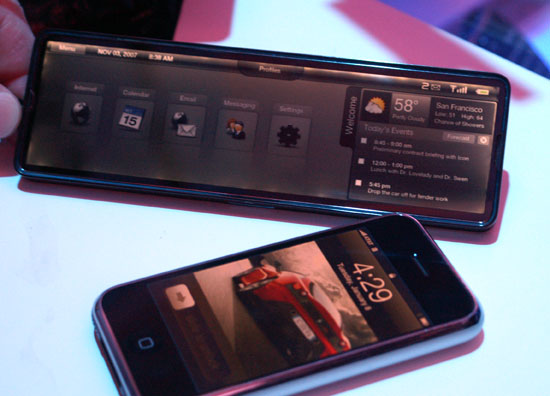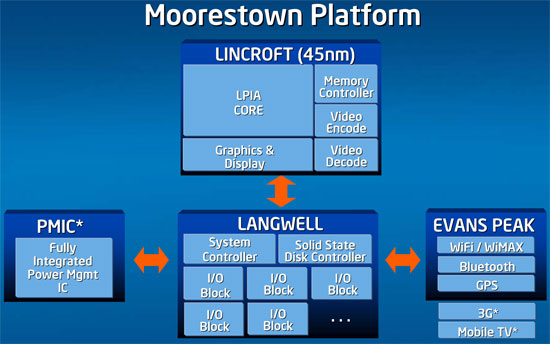Intel's Atom Architecture: The Journey Begins
by Anand Lal Shimpi on April 2, 2008 12:05 AM EST- Posted in
- CPUs
Final Words
Over the next six months we will begin seeing the first devices based on Intel's Atom processor. For 2008, Intel expects to see Atom used primarily in 5" form factor MIDs (Mobile Internet Devices). I've played with prototypes of these Atom based MIDs and honestly, they are not any more impressive than the UMPCs that preceded them. The interfaces are sluggish, the devices are still too bulky and I'm not completely convinced that they're worth the added hassle of carrying one around with me all day.
Intel seems to think that Atom based portable GPS devices will be some of the more interesting devices out this year, and while I see some potential there I'm just not that excited.
It's a shame because I am quite excited about the Atom processor, or its future to be more specific. I'm honestly fed up with poor performance in just about every consumer electronics device that I live with - I want the sort of responsiveness that I get with my desktop or notebook, but I want that in my cable box, in my TVs, mobile phones, Blu-ray players, toasters, etc...
The first iteration of Atom simply won't deliver on enough fronts to make the sort of revolutionary changes I want. It lacks the level of integration necessary for truly portable devices and where I really want to see it isn't in bulky MIDs and UMPCs, but rather in things like the iPhone.

The iPhone (bottom) and a mockup of what the Atom could be in within 3 years (top)
I don't have high expectations for Atom today, while it will surely enable even more EeePC-like devices it's the processor's future that I'm most interested in - and Intel is too. You can find Intel silicon in the majority of desktop and notebook PCs shipped, but if Intel were able to make Atom a success you would find Intel in much, much more. TVs, phones, set top boxes, MIDs, all of these would be running x86 and potentially Intel processors. We always wondered what Intel would do to its spare fab capacity if it integrated a north bridge/memory controller onto its CPUs, with Atom we now have that answer.
The beauty of Atom being successful in these markets is that it doesn't just benefit Intel but AMD and the markets as a whole. Intel will be in for a fight once it begins competing with ARM based processors for space in the CE market, which should promote competition. In those areas where Intel does manage to bring x86 where it hasn't been before, those will quickly become areas where AMD can offer an Atom alternative. Remember that AMD built much of its CPU business on offering a more cost effective x86 alternative to Intel; there's no reason to believe that the same trend won't continue should Atom become successful in the CE industry.
Competition is a very good thing and it's rare that Intel plays the underdog in an industry, but with Atom it most definitely is. The road ahead will be a long one for Intel and its new baby, but the future does look very bright:

What made Atom possible is also what will make it better over time. Moore's law should mean some very interesting things are in store for the processor. The Moorestown update will bring about a more integrated solution, finally enabling Atom to find its way into larger smart phones.

Moorestown will bring an integrated memory controller to Atom among other things...
Take things one step further with an eventual 32nm shrink of Moorestown in the 2011/2012 timeframe and I think we may just be able to have x86 everywhere at the start of the next decade.










46 Comments
View All Comments
adntaylor - Tuesday, April 8, 2008 - link
On that chart with price / power, you need to be clearer...For price, you show the combined price for CPU + Chipset. For power, you say just the CPU... so 0.65W for the CPU... but you're conveniently ignoring the >2W figure for the chipset!!! This absolutely flatters Intel wherever possible.
AMD are just as misleading - they describe the Geode LX as "1W" which excludes the non-CPU core parts of the chip (which is an integrated CPU + GMCH)
Just please be honest - the figures are out there in the Intel datasheets... it takes 10 minutes to check.
Clauzii - Friday, April 4, 2008 - link
I still have a PowerVR 4MB addon card, runnung in tandem with a Rage128Pro. Quite a combination w. 15 FPS in Tombraider. Constant(!) 15FPS, that is..Amazing what they actually achieved back in 95!
Clauzii - Friday, April 4, 2008 - link
Ooops!Totally misplaced that. Sorry.
wimaxltepro - Friday, April 4, 2008 - link
The Atom represents a shift in processor architecture that is the most dramatic departure for Intel since introduction of x86 processors... the philosophy of how computing itself occurs from centralized processors to distributed processing based on an extension of the popular x86 instruction set.The Atom is not about the immediate prospects for the Atom or Nehalem products: we will likely see members of Intel's new product family be used in embedded applications in consumer products and in areas where specialized communications processors are more the rule. While not optimized for use in specific networking applications, the products capitalize on the wide range of support available in IT/Networking to develop common functions that leverage the low cost, low power/processing capability to be used as a common denominator for a wide range of applications.
Intel has been built on the 'Wintel' architecture: massively integrated chips needed to handle the massively integrated operating systems and applications of Windows (and Apple) environments. The Atom allows migration and broadening out from that architectural motif to a very highly distributed architecture. So, the increased parallelism found in the internal chip architecture is enabling of changes in external system architectures and device applications that go well beyond the typical domain of Intel.. and right into the domain of 'personal wireless broadband' and SDWN, Smart Distributed Wireless broadband Network.
The decisions about in-order vs. out of-order instruction streams, memory architecture, I/O architecture have been made in light of the broad vision for how computing, networking and, out of hand, how wireless enabled broadband networking including WiMAX will occur. This should be understood for what it represents as a shift in direction for Intel both in response to broad industry shifts and as a trend setting development.
jtleon - Friday, April 4, 2008 - link
Thanks to all the flash player ads, etc., a mobile web device will continuously avoid switching to low power states. Thus one could argue that advertising will be carbon footprint enemy of the internet's future. This is already becoming the case for desktop/laptop machines.Without such continuous (arguably wasted) consumption of CPU power, then Intel's engineered power management might have a significant impact on the value of the Atom.
Regards,
jtleon
0WaxMan0 - Friday, April 4, 2008 - link
I am definatly much impressed and enthused by intels work here, the future looks interesting esp for those of us who like low power cross compatible computing products.However I have to point out that a low power modern x86 cpu has allready been done infact 4 years ago with AMD's Geode. While technically much weaker than the Atom and with out any where near the scalability (single core design etc.) the Geode has been available in the same TDP ranges for a good long while. Take a look here http://www.amdboard.com/geode.html">http://www.amdboard.com/geode.html for some old stuff.
I do hope that the Intel name and hype makes more of an impact than AMD managed.
whycode - Thursday, April 3, 2008 - link
Does the TDP quoted include the chipset? Or is that CPU only?IntelUser2000 - Thursday, April 3, 2008 - link
Anand, the Pentium M does not feature Macro Ops Fusion. Its Core 2 Duo that started Macro Ops Fusion.Anand Lal Shimpi - Thursday, April 3, 2008 - link
You're correct, I was referencing micro-op fusion. I've made the appropriate correction :)Take care,
Anand
squito - Wednesday, April 2, 2008 - link
Am I the only one shocked to see that Poulsbo is a 130nm part...